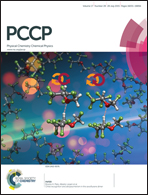Theoretical exploration of the nanoscale host–guest interactions between [n]cycloparaphenylenes (n = 10, 8 and 9) and fullerene C60: from single- to three-potential well†
Abstract
The nanoscale host–guest interactions between [n]cycloparaphenylene ([n]CPP; n = 10, 8 and 9) nano-ring and fullerene C60 were explored theoretically. It is found that relatively small variations in the sizes of the [n]CPP host lead to very significant changes in encapsulation property toward the fullerene C60 guest. Expectedly, one stable inclusion-configuration of [10]CPP⊃C60 and one floating-configuration of [8]CPP⊃C60 are located on the potential surfaces of the two complexes, respectively. Unexpectedly, besides a floating-configuration (F-[9]CPP⊃C60), another stable inclusion-configuration (I-[9]CPP⊃C60) is also located on the potential surface of [9]CPP⊃C60 host–guest complex. Interaction energies and natural steric analysis show that these complexes are stabilized by balancing concave–convex π–π attractive and steric repulsive host–guest interactions. In contrast, the steric repulsive energy (Es) between host and guest of I-[9]CPP⊃C60 is as high as 233.12 kJ mol−1, which is much larger than those in other complexes. The movements of C60 guest through the cavities of [n]CPP host (n = 10, 8 and 9) are simulated by calculating the energy profile, and the results interestingly reveal that the encapsulation of C60 by [10]CPP is in the manner of a single-potential well, by [8]CPP in the manner of a double-potential well, and by [9]CPP in the special manner of a three-potential well. We predict that the movement of C60 guest through the cavity of [9]CPP host should be experimentally observable owing to the relatively low energy barrier (<50 kJ mol−1, M06-2X/6-31G(d)). Charge population analysis shows that an obvious charge transfer between host and guest takes place during the formation of I-[9]CPP⊃C60, which is different from those during the formation of [8]CPP⊃C60, [10]CPP⊃C60 and F-[9]CPP⊃C60. Additionally, the host–guest interaction regions were detected and visualized in real space based on the electron density and reduced density gradient.
![Graphical abstract: Theoretical exploration of the nanoscale host–guest interactions between [n]cycloparaphenylenes (n = 10, 8 and 9) and fullerene C60: from single- to three-potential well](/en/Image/Get?imageInfo.ImageType=GA&imageInfo.ImageIdentifier.ManuscriptID=C5CP02882E&imageInfo.ImageIdentifier.Year=2015)

 Please wait while we load your content...
Please wait while we load your content...